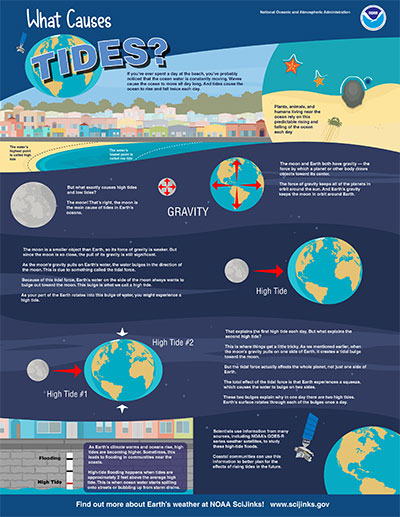Watch this video to learn about what causes tides! Click here to download this video (1920x1080, 103 MB, video/mp4).
Download a poster version of this video!

Click here to download the 8.5x11 poster.
Click here to download the 11x17 poster.
Video transcript
What Causes Tides?
If you’ve ever spent a day at the beach, you’ve probably noticed that the ocean water is constantly moving.
Waves cause the ocean to move all day long. And tides cause the ocean to rise and fall twice each day.
The water’s highest point is called high tide.
The water’s lowest point is called low tide.
Plants, animals, and humans living near the ocean rely on this predictable rising and falling of the ocean each day.
But what exactly causes high tides and low tides?
The moon! That’s right, the moon is the main cause of tides in Earth’s oceans.
The moon and Earth both have gravity — the force by which a planet or other body draws objects toward its center.
The force of gravity keeps all of the planets in orbit around the sun. And Earth’s gravity keeps the moon in orbit around Earth.
The moon is a smaller object than Earth, so its force of gravity is weaker. But since the moon is so close, the pull of its gravity is still significant.
As the moon’s gravity pulls on Earth’s water, the water bulges in the direction of the moon. This is due to something called the tidal force.
Because of this tidal force, Earth’s water on the side of the moon always wants to bulge out toward the moon. This bulge is what we call a high tide.
As your part of the Earth rotates into this bulge of water, you might experience a high tide.
That explains the first high tide each day. But what explains the second high tide?
This is where things get a little tricky. As we mentioned earlier, when the moon’s gravity pulls on one side of Earth, it creates a tidal bulge toward the moon.
But the tidal force actually affects the whole planet, not just one side of Earth.
The total effect of the tidal force is that Earth experiences a squeeze, which causes the water to bulge on two sides.
These two bulges explain why in one day there are two high tides. Earth's surface rotates through each of the bulges once a day.
As Earth’s climate warms and oceans rise, high tides are becoming higher. Sometimes, this leads to flooding in communities near the coasts.
High-tide flooding happens when tides are approximately 2 feet above the average high tide. This is when ocean water starts spilling onto streets or bubbling up from storm drains.
Scientists use information from many sources, including NOAA’s GOES-R series weather satellites, to study these high-tide floods.
Coastal communities can use this information to better plan for the effects of rising tides in the future.
Find out more about Earth’s weather at NOAA SciJinks!




